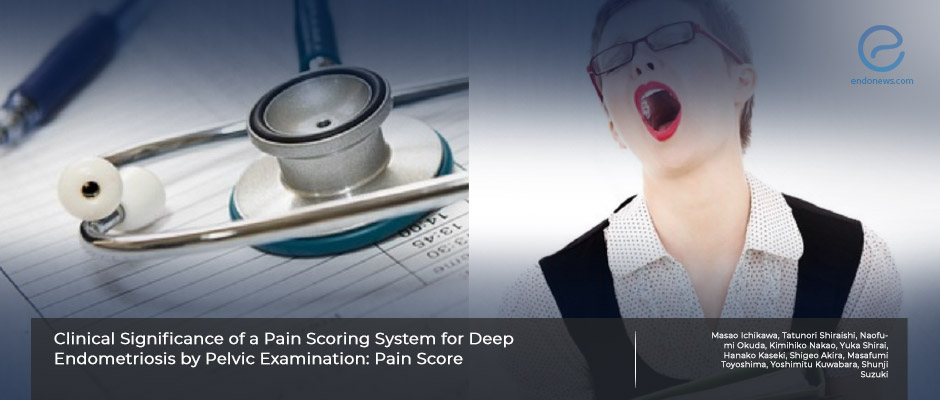Pain Scoring System for Deep Endometriosis
Jul 27, 2023
Scoring pain of endometriosis could help develop surgical strategies for deep endometriosis.
Key Points
Importance:
- The pain score of a patient with endometriosis may reflect the intensity of her endometriotic pain, especially her dyspareunia.
Highlights:
- A local high pain score could suggest deep endometriosis and would be a sign of endometriotic nodules at that site.
- Combining pelvic examination for pain scoring and imaging methods may help identify endometrial nodules preoperatively.
What's done here:
- A Japanese research team used data from a previous prospective study to compare and evaluate the max pain scores of 131 women with endometriosis with deep endometriosis confirmed by surgery.
- Previous data about the pain intensity scoring map consisting of seven equally divided areas of the pelvis of a 3x3 grid were filled by one gynecologist during a bimanual pelvic examination:
- By stimulating the anatomic parts by either pooling, pushing, or compressing, the pain intensity was measured at anatomically matched locations.
- Simultaneously, transvaginal ultrasonography was performed.
- The relationship between pre-and postoperative maximum pain scores, clinical symptoms, and deep endometriosis lesion sites was statistically compared.
Key Results:
- The maximum pain score of 131 women was 5.93 preoperatively, and 3.08 postoperatively.
- The uterine cervix location had the highest pain score, followed by the Douglas pouch and the left and right uterosacral areas among these seven regions.
- The maximum pain score was most strongly correlated with dyspareunia among the four significant clinical symptoms of endometriosis.
- In about two-thirds of the patients, the maximum postoperative pain score improved by at least 50%.
- One month after the surgery, the maximum pain score was improved in 83% of the patients, while 6% were unchanged, and 11% experienced worsening.
- When comparing pre- and postoperative pain scores, it has been realized that deep endometriotic nodules were the most critical factor causing high pain scores.
Lay Summary
The numeric pain scale is commonly used to interpret pain score values. According to the National Comprehensive Cancer Network guidelines, pain scores of 4-7 points indicate moderate, and 8-10 points indicate severe pain. Patients with a local pain score of 4 or higher should be addressed to the surgery and deserve drugs other than painkillers, preferably opioids.
Pain scoring is an examination method to detect endometriosis-associated pain by pelvic examination alone. The uterus and surrounding regions can be divided into seven areas to facilitate finding the location of the pain. These are the anterior vaginal wall, uterine cervix, right and left adnexa, right and left uterosacral ligaments, and the pouch of Douglas. During the pelvic examination, the right index finger pushes and stimulates the mentioned areas.
Dr. Ichikawa et al. from the Department of Gynecology and Obstetrics of Nippon Medical School, Tokyo, Japan, aimed to investigate the relationship between pain scores and clinical symptoms of endometriosis or deep-located endometriotic lesion. They used previous prospective study results of 131 women as preoperative and postoperative pain scoring.
The most prominent finding was that the highest pain score was located at the uterine cervix among the above 7 areas mentioned during the pelvic examination.
At the surgery, 94 patients had partial or complete obliteration of the Douglas pouch and only 9 underwent complete resection of the lesions. In 61 cases with unilateral endometrioma, the mean pain scores in the adnexal area with or without cysts were almost the same, thus, the presence of endometrioma alone should not be the cause of pain.
The correlation between max pain scores and the clinical symptoms of endometriosis such as dysmenorrhea, perimenstrual dyschezia, and chronic pelvic pain, were almost the same but dyspareunia was the strongest.
The article was recently published in the journal named "Diagnostics", and the conclusion was "The pain score serves as an index for determining the localization, spread, and activity of endometriotic lesions and also serves as a criterion for deciding the excision range."
Research Source: https://pubmed.ncbi.nlm.nih.gov/37238258/
pain score deep endometriosis dysmenorrhea dyspareunia chronic pelvic pain endometriotic nodule obliteration of the Douglas pouch retroflexed uterus adenomyosis endometriosis.

